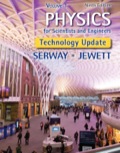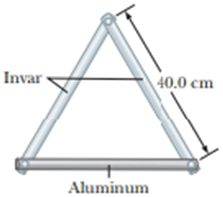
Concept explainers
Two metal bars are made of invar and a third bar is made of aluminum. At 0°C, each of the three bars is drilled with two holes 40.0 cm apart. Pins are put through the holes to assemble the bars into an equilateral triangle as in Figure P18.31. (a) First ignore the expansion of the invar. Find the angle between the invar bars as a function of Celsius temperature. (b) Is your answer accurate for negative as well as positive temperatures? (c) Is it accurate for 0°C? (d) Solve the problem again, including the expansion of the invar. Aluminum melts at 660°C and invar at 1 427°C. Assume the tabulated expansion coefficients are constant. What are (e) the greatest and (f) the smallest attainable angles between the invar bars?
Figure P18.31

(a)
Answer to Problem 19.54AP
Explanation of Solution
Given info: The distance between two holes drilled at
In the given diagram consider the right triangle that each invar bar makes with one half of the aluminum bar.
Then, the angle is,
Here,
Rearrange the above equation for
Conclusion:
Therefore, the angle between the invar bars as a function of Celsius temperature is
(b)
Answer to Problem 19.54AP
Explanation of Solution
Given info: The distance between two holes drilled at
If the temperature drops, the Celsius temperature becomes negative. The negative value of the Celsius temperature describes the contraction of the bars. So the answer is accurate for the negative temperature same as the positive temperature.
Conclusion:
Therefore, yes the answer is accurate for negative as well as positive temperature.
(c)
Answer to Problem 19.54AP
Explanation of Solution
Given info: The distance between two holes drilled at
The expression for the angle between the invar bars is,
Substitute
The value of each angle of the right angle triangle is
Conclusion:
Therefore, Yes, the answer is accurate at
(d)
Answer to Problem 19.54AP
Explanation of Solution
Given info: The distance between two holes drilled at
In the given diagram consider the right triangle that each invar bar makes with one half of the aluminum bar.
Then, the angle between invar bars and aluminum bar is,
Here,
Rearrange the above equation for
Conclusion:
Therefore, the angle between the invar bars and the aluminum bar as a function of Celsius temperature is
(e)
Answer to Problem 19.54AP
Explanation of Solution
Given info: The distance between two holes drilled at
The average coefficient of linear expansion of the aluminum is
The average coefficient of linear expansion of the invar is
The greatest angle is occur at
The equation for the angel between the invar bars is,
Substitute
Conclusion:
Therefore, the greatest attainable angle between the invar bars is
(f)
Answer to Problem 19.54AP
Explanation of Solution
Given info: The distance between two holes drilled at
The average coefficient of linear expansion of the aluminum is
The average coefficient of linear expansion of the invar is
The smallest angle is occur at
The equation for the angel between the invar bars is,
Substitute
Conclusion:
Therefore, the smallest attainable angle between the invar bars is
Want to see more full solutions like this?
Chapter 19 Solutions
EBK PHYSICS FOR SCIENTISTS AND ENGINEER
- No chatgpt pls will upvotearrow_forward1.62 On a training flight, a Figure P1.62 student pilot flies from Lincoln, Nebraska, to Clarinda, Iowa, next to St. Joseph, Missouri, and then to Manhattan, Kansas (Fig. P1.62). The directions are shown relative to north: 0° is north, 90° is east, 180° is south, and 270° is west. Use the method of components to find (a) the distance she has to fly from Manhattan to get back to Lincoln, and (b) the direction (relative to north) she must fly to get there. Illustrate your solutions with a vector diagram. IOWA 147 km Lincoln 85° Clarinda 106 km 167° St. Joseph NEBRASKA Manhattan 166 km 235° S KANSAS MISSOURIarrow_forwardPlz no chatgpt pls will upvotearrow_forward
- 3.19 • Win the Prize. In a carnival booth, you can win a stuffed gi- raffe if you toss a quarter into a small dish. The dish is on a shelf above the point where the quarter leaves your hand and is a horizontal dis- tance of 2.1 m from this point (Fig. E3.19). If you toss the coin with a velocity of 6.4 m/s at an angle of 60° above the horizontal, the coin will land in the dish. Ignore air resistance. (a) What is the height of the shelf above the point where the quarter leaves your hand? (b) What is the vertical component of the velocity of the quarter just before it lands in the dish? Figure E3.19 6.4 m/s 2.1arrow_forwardCan someone help me answer this thank you.arrow_forward1.21 A postal employee drives a delivery truck along the route shown in Fig. E1.21. Determine the magnitude and direction of the resultant displacement by drawing a scale diagram. (See also Exercise 1.28 for a different approach.) Figure E1.21 START 2.6 km 4.0 km 3.1 km STOParrow_forward
- help because i am so lost and it should look something like the picturearrow_forward3.31 A Ferris wheel with radius Figure E3.31 14.0 m is turning about a horizontal axis through its center (Fig. E3.31). The linear speed of a passenger on the rim is constant and equal to 6.00 m/s. What are the magnitude and direction of the passenger's acceleration as she passes through (a) the lowest point in her circular motion and (b) the high- est point in her circular motion? (c) How much time does it take the Ferris wheel to make one revolution?arrow_forward1.56 ⚫. Three horizontal ropes pull on a large stone stuck in the ground, producing the vector forces A, B, and C shown in Fig. P1.56. Find the magnitude and direction of a fourth force on the stone that will make the vector sum of the four forces zero. Figure P1.56 B(80.0 N) 30.0 A (100.0 N) 53.0° C (40.0 N) 30.0°arrow_forward
 College PhysicsPhysicsISBN:9781285737027Author:Raymond A. Serway, Chris VuillePublisher:Cengage Learning
College PhysicsPhysicsISBN:9781285737027Author:Raymond A. Serway, Chris VuillePublisher:Cengage Learning Principles of Physics: A Calculus-Based TextPhysicsISBN:9781133104261Author:Raymond A. Serway, John W. JewettPublisher:Cengage Learning
Principles of Physics: A Calculus-Based TextPhysicsISBN:9781133104261Author:Raymond A. Serway, John W. JewettPublisher:Cengage Learning Physics for Scientists and Engineers: Foundations...PhysicsISBN:9781133939146Author:Katz, Debora M.Publisher:Cengage Learning
Physics for Scientists and Engineers: Foundations...PhysicsISBN:9781133939146Author:Katz, Debora M.Publisher:Cengage Learning College PhysicsPhysicsISBN:9781305952300Author:Raymond A. Serway, Chris VuillePublisher:Cengage Learning
College PhysicsPhysicsISBN:9781305952300Author:Raymond A. Serway, Chris VuillePublisher:Cengage Learning Physics for Scientists and Engineers, Technology ...PhysicsISBN:9781305116399Author:Raymond A. Serway, John W. JewettPublisher:Cengage Learning
Physics for Scientists and Engineers, Technology ...PhysicsISBN:9781305116399Author:Raymond A. Serway, John W. JewettPublisher:Cengage Learning Physics for Scientists and EngineersPhysicsISBN:9781337553278Author:Raymond A. Serway, John W. JewettPublisher:Cengage Learning
Physics for Scientists and EngineersPhysicsISBN:9781337553278Author:Raymond A. Serway, John W. JewettPublisher:Cengage Learning





